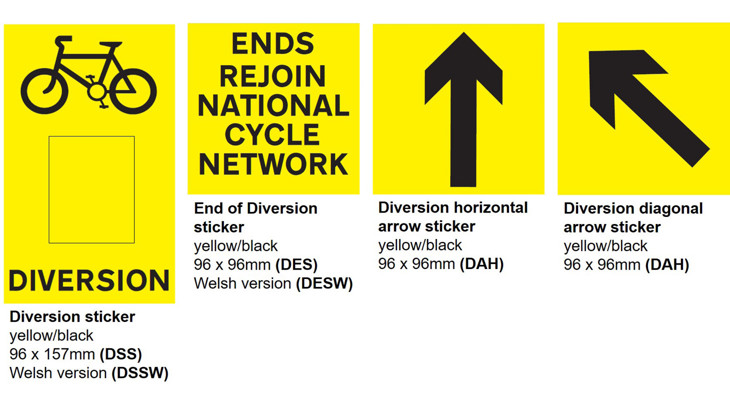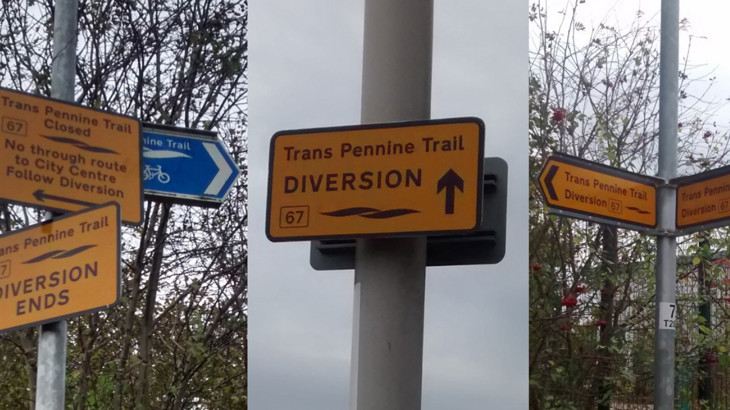Temporary diversions of National Cycle Network routes
This guidance sets out the level of provision that should be made where it is necessary to temporarily divert a National Cycle Network route.
Key principles
- The standard of provision should be in line with current design guidance, including provision at road crossings.
- The needs of all users should be considered in the standard of provision for a temporary diversion.
- Temporary diversions should be signed clearly so that they are easy to follow.
1.1 Level of provision
1.1.1
The standard of provision for a temporary diversion should be in accordance with the relevant current design guidance:
- England: LTN 1/20, Highways England CD 195 or London Cycling Design Standards
- Wales: Active Travel Act Design Guide
- Scotland: Cycling by Design
- Northern Ireland: LTN1/20.
1.1.2
The following guidance specifically relating to provision for active travel in relation to street works and road works should also be referred to:
- Wales: 114/20 supplementary guidance for the safety at street works and road works a code of practice 2013
- London: TfL temporary traffic management handbook.
1.1.3
The standard of provision for the diversion route should match the existing provision in terms of the National Cycle Network (the Network) design principles.
For example, the diversion for a traffic-free route would also be traffic-free.
1.1.4
Where it is necessary for a temporary diversion of a traffic-free route to be on-road protected space should be provided for Network users.
This could be achieved with the provision of cones, barriers or wands to delineate space protected from motor traffic.
1.1.5
Where it is not possible to provide a temporary diversion that meets current design guidance then a risk assessment must be undertaken to identify the hazards associated with the level of provision for all potential users of the diversion and measures implemented to mitigate the risks.
In these cases, it may be necessary to provide a longer diversion route to avoid diverting Network users onto a heavily trafficked, high-speed road.
1.1.6
Particular consideration should be given to the standard of provision where temporary diversions involve Network users having to negotiate junctions or crossroads.
As far as reasonably practicable the diversion should be in accordance with current design guidance.
Where Network users are required to cross roads temporary toucan traffic signals should be provided.
1.1.7
Where the diversion route involves cyclists sharing the carriageway with motor traffic consideration should be given to the lane widths provided, especially where existing traffic lanes may have been narrowed to pass through roadworks.
Lane widths between 3.2 and 3.9 metres should be avoided.
1.1.8
Consideration should be given to the surfacing of a temporary diversion.
In most cases, the duration of a diversion will only justify a temporary surface.
Designers should consider how accessible the surface is for different users and in different weather conditions.
Additionally, how will the surface perform under trafficking? For example, if rubberised ground mats are used, will the panels settle and cause trip hazards.

Rubberised ground protection matting is used as a temporary surface. It's weatherproof but what about trip hazards?
1.1.9
The width of any temporary diversion should be comparable to the existing route.
Where it is not practicable to provide this the impact on users should be assessed to inform the necessary mitigation measures.
1.1.10
Temporary diversions should not require people cycling to have to dismount.
1.1.11
The following factors may influence the standard of provision that is required for a temporary diversion.
- The length of time that a diversion is needed for. A diversion that is going to be in place for months may justify a higher level of provision than one that is required for a few days.
- The provision on the existing route. If the existing route is on-road then an on-road diversion may be appropriate.
- The nature of the use of the existing route. A route that is less heavily used in the winter may only require a lower standard of provision if the diversion is required in the winter. A well-used route will require a higher quality of provision.
- The reason for the diversion. A diversion required in an emergency may justify a lower provision to a diversion that can be planned. A diversion required to accommodate third party works on land that is maintainable at the public expense should include a budget for mitigating the impact on users.
1.2 User experience
1.2.1
The needs of all users reasonably expected to be using the Network route should be considered as part of the design of a temporary diversion. Considerations may include:
- For people walking or wheeling: are diversion routes step-free, where people have to cross a road have dropped kerbs, or footway ramps been provided?
- For people using non-standard or adapted cycles: Is the diversion negotiable by larger cycles, does it require people to dismount, and if so, which users will be excluded?
- For people riding horses, where applicable: is the diversion route suitable for horse riding?
- For all users: is there sufficient width to enable all users to access the diversion route?
- For all users: have temporary signs, for the diversion or roadworks, been placed so as not to obstruct or restrict the space available for people walking, wheeling, cycling or riding?
1.2.2
All temporary diversions should be assessed from a personal safety perspective.
The diversion route should be well overlooked and may need to be lit, depending on the nature of the route.
1.2.3
An equality impact assessment should be undertaken to consider the impact of the temporary diversion on all users and specifically those with protected characteristics.
1.2.4
The local community and users of the route should be engaged with as part of the planning of a temporary diversion.
As a minimum, advance warning of the diversion should be provided, both on the ground and via digital channels, including online mapping.
Sustrans should be informed of the path closure, at least 14 days in advance so that the closure and diversion route can be publicised through our media channels and online mapping.
Notifications should be sent to pathsforeveryone@sustrans.org.uk.
1.3 Signing
1.3.1
Temporary diversions should be signed in a way that ensures that the diversion is easy to follow for all users, in both directions.
Consideration should be given to the size and positioning of signs to ensure that they are legible to all users and do not obstruct or restrict the diversion route.
1.3.2
There are a number of Sustrans-style National Cycle Network signs available that may be useful for signing temporary diversions as shown below.

Sustrans-style temporary diversion signs (components used to assemble a full sign).
1.3.3
Longer-term diversions may justify the use of more permanent signing.
Any signing should be removed once the diversion is no longer in place.

More permanent signs suitable for a longer-term diversion.
1.3.4
Signing on the public highway should be designed in accordance with the Traffic Signs Regulations and General Directions.


